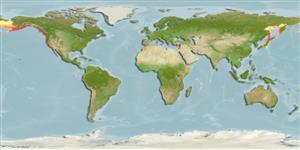Classification / Names
Common names from other countries
Main reference
Size / Weight / Age
Max length : 122 cm TL male/unsexed; (Ref. 96339); common length : 60.0 cm TL male/unsexed; (Ref. 5504); max. published weight: 25.4 kg (Ref. 7251); max. reported age: 11 years (Ref. 12193)
Length at first maturity
Lm ? range ? - ? cm
Environment
Marine; freshwater; brackish; benthopelagic; anadromous (Ref. 51243); depth range 0 - 200 m (Ref. 50550)
Climate / Range
Subtropical; 10°C - 24°C (Ref. 12741), preferred 8°C (Ref. 107945); 67°N - 32°N, 135°E - 117°W
Distribution
Native to Pacific Slope from Kuskokwim River, Alaska to (at least) Rio Santa Domingo, Baja California, Mexico; upper Mackenzie River drainage (Arctic basin), Alberta and British Columbia in Canada; endorheic basins of southern Oregon, USA. Widely introduced in cold waters elsewhere in North America and rest of the world (Ref. 5723). Eastern Pacific: Kamchatkan Peninsula and have been recorded from the Commander Islands east of Kamchatka and sporadically in the Sea of Okhotsk as far south as the mouth of the Amur River along the mainland. The records outside Kamchatka probably represent migrating or straying Kamchatkan steelhead (penshinensis) rather than the established native population (Reg. 50080). Several countries report adverse ecological impact after introduction.
Countries | FAO areas | Ecosystems | Occurrences | Introductions
Short description
Dorsal
spines
(total): 0;
Dorsal
soft rays
(total): 10-12;
Anal
spines: 0;
Anal
soft rays: 8 - 12;
Vertebrae: 60 - 66. Body elongate, somewhat compressed especially in larger fish. No nuptial tubercles but minor changes to head, mouth and color occur especially in spawning males. Coloration varies with habitat, size, and sexual condition. Stream residents and spawners darker, colors more intense. Lake residents lighter, brighter, and more silvery. Caudal fin with 19 rays (Ref. 2196). Differs from Oncorhynchus gorbuscha by having the following unique characters: by having the following unique characters: anal fin with 6-9½ (usually 8½ ) branched rays; 115-130 scales in midlateral row; 16-17 gill rakers; breeding males lacking hump; juveniles lacking parr marks; wide pink to red stripe from head to caudal base, except in sea-run form; and juveniles with 5-10 parr marks (Ref. 59043).
IUCN Red List Status (Ref. 115185)
Threat to humans
Potential pest
Human uses
Fisheries: highly commercial; aquaculture: commercial; gamefish: yes
Tools
Special reports
Download XML
Internet sources
Estimates of some properties based on models
Phylogenetic diversity index
PD50 = 0.5000 many relatives (e.g. carps) 0.5 - 2.0 few relatives (e.g. lungfishes)
Trophic Level
4.1 ±0.3 se; Based on diet studies.
Resilience
Medium, minimum population doubling time 1.4 - 4.4 years (K=0.38-0.46; tm=2-5; tmax=11; Fec=200)
Vulnerability
Moderate vulnerability (36 of 100)
Price category
